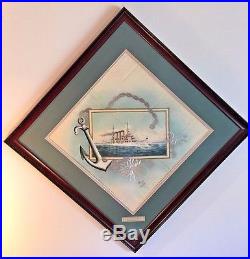
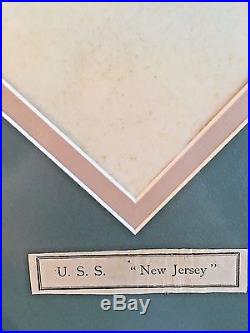
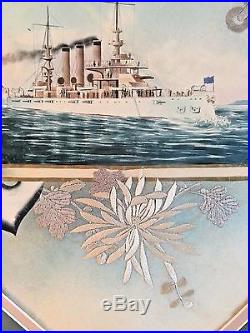
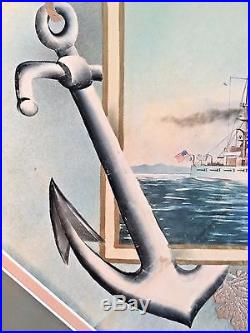
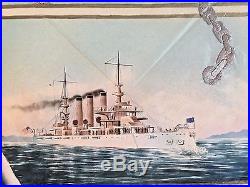


The New Jersey battleship was launched 7 December 1942 by the Philadelphia Naval Shipyard. The New Jersey was Americas most decorated battleship & surviving warship. This original Japanese Silk Hand embroidered souvenir handkerchief is Framed behind Museum Glass with a Mahogany wood frame. Frame size: 27 1/4 by 27 1/4 by 27 1/4. Silk size: 18 inches square. Professionally framed with loving care. Has original nameplate in the frame at the bottom. The cost to send one of these would have been 3 cents. Battleship New Jersey Museum. The Battleship served in. As far as I can tell this is a one of a kind. I have been searching for something close to this piece for 6 months. I have not found anything as beautifully done. Please, I welcome any information on this silk embroidered handkerchief and I will be happy to post it so everyone can enjoy the information. This needs to be picked up. I would rather have this picked up. FULL HISTORY of Battleship New Jersey. The New Jersey (BB-62) was launched 7 December 1942 by the Philadelphia Naval Shipyard; sponsored by Mrs. Charles Edison, wife of Governor Edison of New Jersey, former Secretary of the Navy; and commissioned at Philadelphia 23 May 1943, Captain Carl F. New Jersey completed fitting out and trained her initial crew in the Western Atlantic and Caribbean. On 7 January 1944 she passed through the Panama Canal war-bound for Funafuti, Ellice Islands. She reported there 22 January for duty with the Fifth Fleet, and three days later rendezvoused with Task Group 58.2 for the assault on the Marshall Islands. New Jersey screened the carriers from enemy attack as their aircraft flew strikes against Kwajalein and Eniwetok 29 January-2 February, softening up the latter for its invasion and supporting the troops who landed 31 January. New Jersey began her distinguished career as a flagship 4 February in Majuro Lagoon when Admiral Raymond A. Spruance, commanding the Fifth Fleet, broke his flag from her main. Her first action as a flagship was a bold two-day surface and air strike by her task force against the supposedly impregnable Japanese fleet base on Truk in the Carolines. This blow was coordinated with the assault on Kwajalein, and effectively interdicted Japanese naval retaliation to the conquest of the Marshalls. On 17 and 18 February; the task force accounted for two Japanese light cruisers, four destroyers, three auxiliary cruisers, two submarine tenders, two submarine chasers, an armed trawler, a plane ferry, and 23 other auxiliaries, not including small craft. New Jersey destroyed a trawler and, with other ships, sank destroyer Maikaze, as well as firing on an enemy plane which attacked her formation. Between 17 March and 10 April, New Jersey first sailed with Rear Admiral Marc A. Upon his return to Majuro, Admiral Spruance transferred his flag to USS Indianapolis (CA-35). New Jerseys next war cruise, 13 April-4 May 1944, began and ended at Majuro. New Jersey and her formation splashed two enemy torpedo bombers at Truk. Her sixteen-inch salvos pounded Ponape 1 May, destroying fuel tanks, badly damaging the airfield, and demolishing a headquarters building. After rehearsing in the Marshalls for the invasion of the Marianas, New Jersey put to sea 6 June in the screening and bombardment group of Admiral Mitschers Task Force. On the second day of preinvasion air strikes, 12 June, New Jersey downed an enemy torpedo bomber, and during the next two days her heavy guns battered Saipan and Tinian, throwing steel against the beaches the marines would charge 15 June. The Japanese response to the Marianas operation was an order to its Mobile Fleet; it must attack and annihilate the American invasion force. Shadowing American submarines tracked the Japanese fleet into the Philippine Sea as Admiral Spruance joined his task force with Admiral Mitschers to meet the enemy. New Jersey took station in the protective screen around the carriers on 19 June 1944 as American and Japanese pilots dueled in the Battle of the Philippine Sea. That day and the next were to pronounce the doom of Japanese naval aviation; in this Marianas Turkey Shoot, the Japanese lost some 400 planes. This loss of trained pilots and aircraft was equaled in disaster by the sinking of three Japanese carriers by submarines and aircraft, and the damaging of two carriers and a battleship. The anti- aircraft fire of New Jersey and the other screening ships proved virtually impenetrable. Only two American ships were damaged, and those but slightly. In this overwhelming victory but 17 American planes were lost to combat. New Jerseys final contribution to the conquest of the Marianas was in strikes on Guam and the Palaus from which she sailed for Pearl Harbor, arriving 9 August. Here she broke the flag of Admiral William F. 24 August, becoming flagship of the Third Fleet. For the eight months after she sailed from Pearl Harbor 30 August New Jersey was based at Ulithi. New Jersey offered the essential protection required by these forces, always ready to repel enemy air or surface attack. In September the targets were in the Visayas and the southern Philippines, then Manila and Cavite, Panay, Negros, Leyte, and Cebu. Early in October raids to destroy enemy air power based on Okinawa and Formosa were begun in preparation for the Leyte landings 20 October 1944. This invasion brought on the desperate, almost suicidal, last great sortie of the Imperial Japanese Navy. Its plan for the Battle for Leyte Gulf included a feint by a northern force of planeless heavy attack carriers to draw away the battleships, cruisers and fast carriers with which Admiral Halsey was protecting the landings. This was to allow the Japanese Center Force to enter the gulf through San Bernadino Strait. At the opening of the battle planes from the carriers guarded by USS New Jersey struck hard at both the Japanese Southern and Center Forces, sinking a battleship 23 October. The next day Halsey shaped his course north after the decoy force had been spotted. Planes from his carriers sank four of the Japanese carriers, as well as a destroyer and a cruiser, while New Jersey steamed south at flank speed to meet the newly developed threat of the Center force. It had been turned back in a stunning defeat when she arrived. New Jersey rejoined her fast carriers near San Bernadino 27 October 1944 for strikes on central and southern Luzon. Two days later, the force was under suicide attack. In a melee of anti- aircraft fire from the ships and combat air patrol, New Jersey shot down a plane whose pilot maneuvered it into USS Intrepids (CV- 11) port gun galleries, while machine gun fire from Intrepid wounded three of New Jerseys men. During a similar action 25 November three Japanese planes were splashed by the combined fire of the force, part of one flaming onto USS Hancocks (CV-19) flight deck. Intrepid was again attacked, shot down one would-be suicide, but was crashed by another despite hits scored on the attacker by New Jersey gunners. New Jersey shot down a plane diving on USS Cabot (CVL-28) and hit another which smashed into Cabots port bow. In December, New Jersey sailed with the USS Lexington (CV 16) task group for air attacks on Luzon 14-16 December; then found herself in the furious typhoon which sank three destroyers. Skillful seamanship brought her through undamaged. New Jersey ranged far and wide from 30 December 1944 to 25 January 1945 on her last cruise as Admiral Halseys flagship. She guarded the carriers in their strikes on Formosa, Okinawa, and Luzon, on the coast of Indo-China, Hong Kong, Swatow and Amoy, and again on Formosa and Okinawa. At Ulithi 27 January Admiral Halsey lowered his flag in New Jersey, but it was replaced two days later by that of Rear Admiral Oscar Badger commanding Battleship Division Seven. In support of the assault on Iwo Jima, New Jersey screened the USS Essex (CV-9) group in air attacks on the island 19-21 February, and gave the same crucial service for the first major carrier raid on Tokyo 25 February, a raid aimed specifically at aircraft production. During the next two days, Okinawa was attacked from the air by the same striking force. New Jersey was directly engaged in the conquest of Okinawa from 14 March until 16 April. As the carriers prepared for the invasion with strikes there and on Honshu, New Jersey fought off air raids, used her seaplanes to rescue downed pilots, defended the carriers from suicide planes, shooting down at least three and assisting in the destruction of others. On 24 March 1945 she again carried out the vital battleship role of heavy bombardment, preparing the invasion beaches for the assault a week later. During the final months of the war, New Jersey was overhauled at Puget Sound Naval Shipyard, from which she sailed 4 July for San Pedro, Pearl Harbor, and Eniwetok bound for Guam. Here on 14 August she once again became flagship of the Fifth Fleet under Admiral Spruance. Brief stays at Manila and Okinawa preceded her arrival in Tokyo Bay 17 September, where she served as flagship for the successive commanders of Naval Forces in Japanese waters until relieved 28 January 1946 by USS Iowa (BB-61). New Jersey took aboard nearly a thousand homeward-bound troops with whom she arrived at San Francisco 10 February. After west coast operations and a normal overhaul at Puget Sound, New Jerseys keel once more cut the Atlantic as she came home to Bayonne, New Jersey, for a rousing fourth birthday part 23 May 1947. Present were Governor Alfred E. Driscoll, former Governor Walter E. Edge and other dignitaries. Between 7 June and 26 August, New Jersey formed part of the first training squadron to cruise Northern European waters since the beginning of World War II. Over two thousand Naval Academy and NROTC midshipmen received sea-going experience under the command of Admiral Richard L. Connoly, Commander Naval Forces Eastern Atlantic and Mediterranean, who broke his flag in New Jersey at Rosyth, Scotland 23 June. She was the scene of official receptions at Oslo, where King Haakon VII of Norway inspected the crew 2 July, and at Portsmouth, England. The training fleet was westward bound 18 July for exercises in the Caribbean and Western Atlantic. After serving at New York as flagship for Rear Admiral Heber H. McClean, Commander, Battleship Division One, 12 September-18 October, New Jersey was inactivated at the New York Naval Shipyard. She was decommissioned at Bayonne 30 June 1948 and assigned to the New York Group, Atlantic Reserve Fleet. New Jersey was recommissioned at Bayonne 21 November 1950, Captain David M. In the Caribbean she welded her crew into an efficient body which would meet with distinction the demanding requirements of the Korean War. She sailed from Norfolk 16 April 1951 and arrived from Japan off the east coast of Korea 17 May. Vice Admiral Harold M. Martin, commanding the Seventh Fleet. Placed his flag in New Jersey for the next six months. New Jerseys guns opened the first shore bombardment of her Korean carrier at Wonsan 20 May. During her two tours of duty in Korean waters, she was again and again to play the part of seaborne mobile artillery. In direct support to United Nations troops; or in preparation for ground actions, in interdicting Communist supply and communication routes, or in destroying supplies and troop positions, New Jersey hurled a weight of steel, fire far beyond the capacity of land artillery, moved rapidly and free from major attack from one target to another, and at the same time could be immediately available to guard aircraft carriers should they require her protection. It was on this first such mission at Wonsan that she received her only combat casualties of the Korean War. One of her men was killed and two severely wounded when she took a hit from a shore battery on her number one turret and received a near miss aft to port. Between 23 and 27 May and again 30 May 1951, New Jersey pounded targets near Yangyang and Kansong, dispersing troop concentrations, dropping a bridge span, and destroying three large ammunition dumps. Air spotters reported Yangyang abandoned at the end of this action, while railroad facilities and vehicles were smashed at Kansong. On 24 May, she lost one of her helicopters when its crew pushed to the limit of their fuel searching for a downed aviator. With Admiral Arthur W. Radford, Commander in Chief Pacific Fleet, and Vice Admiral C. Turner Joy, Commander Naval Forces Far East aboard, New Jersey bombarded targets at Wonsan 4 June. At Kansong two days later she fired her main battery at an artillery regiment and truck encampment, with Seventh Fleet aircraft spotting targets and reporting successes. On 28 July off Wonsan the battleship was again taken under fire by shore batteries. Several near misses splashed to port, but New Jerseys precision fire silenced the enemy and destroyed several gun emplacements. Between 4 and 12 July, New Jersey supported a United Nations push in the Kansong area, firing at enemy buildup and reorganization positions. As the, Republic of Koreas First Division hurled itself on the enemy, shore fire control observers saw New Jerseys salvos hit directly on enemy mortar emplacements, supply and ammunition dumps, and personnel concentrations. New Jersey sailed to the aid of troops of the Republic of Korea once more 17 August, returning to the Kansong area where for four days she provided harassing fire by night, and broke up counterattacks by day, inflicting a heavy toll on enemy troops. The next day she an a three-day saturation of the Changjon area, with one of her own helicopters spotting the results: four buildings; destroyed, road junctions smashed, railroad marshaling yards afire, tracks cut and uprooted, coal stocks scattered, many buildings and warehouses set blazing. Aside from a brief break in firing 23 September to take aboard wounded from the Korean frigate Apnok (PF-62), damaged by gunfire, New Jersey was heavily engaged in bombarding the Kansong area, supporting the movement of the U. The pattern again was harassing fire by night, destruction of known targets by day. Enemy movement was restricted by the fire of her big guns. A bridge, a dam, several gun emplacements, mortar positions, pillboxes, bunkers, an two ammunition dumps were demolished. On 1 October 1951, General Omar Bradley, Chairman of the Joint Chiefs; of Staff, and General Matthew B. Ridgeway, Commander in Chief Far East, came on board to confer with Admiral Martin. Between 1 and 6 October New Jersey was in action daily at Kansong, Hamhung, Hungnam, Tanchon, and Songjin. Enemy bunkers and supply concentrations provided the majority of the targets at Kansong; at the others New Jersey fired on railroads, tunnels, bridges, an oil refinery, trains, and shore batteries destroying with five-inch fire a gun that straddled her. The Kojo area was her target 16 October as she sailed in company with HMS Belfast, pilots from HMAS Sydney spotting. The operation was well-planned and coordinated ad excellent results were obtained. Another highly satisfactory day was 16 October, when the spotter over the Kansong area reported beautiful shooting every shot on target-most beautiful shooting I have seen in five years. This five hour bombardment leveled ten artillery positions, and in smashing trenches and bunkers inflicted some 500 casualties. New Jersey dashed up the North Korean coast raiding transportation facilities from 1 to 6 November. She struck at bridges, road and rail installations at Wonsan, Hungnam, Tanchon, Iowon, Songjin, and Chongjin, and left smoking behind her four bridges destroyed, others badly damaged, two marshaling yards badly torn up, and many feet of track destroyed. With renewed attacks on Kansong and near the Chang-San-Got Peninsula 11 and 13 November, New Jersey completed this tour of duty. Between 19 July 1952 and 5 September, she sailed as flagship for Rear Admiral H. Thurber, who commanded the NROTC midshipman training cruise to Cherbourg, Lisbon, and the Caribbean. Now New Jersey prepared and trained for her second Korean tour, for which she sailed from Norfolk 5 March 1953. Clark, Commander Seventh Fleet. At Pusan two days later, New Jersey manned her rails to welcome the President of the Republic of Korea and Madame Rhee, and American Ambassador Ellis O. New Jersey fired on coastal batteries and buildings at Kojo 16 April; on railway track and tunnels near Hungnam 18 April; and on gun emplacements around Wonsan Harbor 20 April, silencing them in five areas after she had herself take several near misses. Songjin provided targets 23 April. Her New Jersey scored six direct 16-inch hits on a railroad tunnel and knocked out two rail bridges. New Jersey added her muscle to a major air and surface strike on Wonsan 1 May, as Seventh Fleet planes both attacked the enemy and spotted for the battleship. She knocked out eleven Communist shore guns that day, and four days later destroyed the key observation post on the island of Hodo Pando, commanding the harbor. Two days later Kalmagak at Wonsan was her target. Her tenth birthday, 23 May 1953, was celebrated at Inchon with President and Madame Rhee, Lieutenant General Maxwell D. Taylor, and other dignitaries on board. Two days later New Jersey was all war once more, returning to the west coast at Chinampo to knock out harbor defense positions. The battleship was under fire at Wonsan 27-29 May, but her five- inch guns silenced the counter-fire, and her 16-inch shells destroyed five gun emplacements and four gun caves. She also hit a target that flamed spectacularly: either a fuel storage area or an ammunition dump. On her first mission, she completely destroyed two gun positions, an observation post, and their supporting trenches, then stood by on call for further aid. Then it was back to Wonsan for a day-long bombardment 24 June, aimed at guns placed in caves. The results were excellent, with eight direct hits on three caves, one cave demolished, and four others closed. At Wonsan 11-12 July, New Jersey fired one of the most concentrated bombardments of her Korean duty. For nine hours the first day, and for seven the second, her guns slammed away on gun positions and bunkers on Hodo Pando and the mainland with telling effect. At least ten enemy guns were destroyed, many damaged, and a number of caves and tunnels sealed. New Jersey smashed radar control positions and bridges at Kojo 13 July, and was once more on the east coast bombline 22-24 July to support South Korean troops near Kosong. These days found her gunners at their most accurate and the devastation wrought was impressive. A large cave, housing an important enemy observation post was closed, the end of a month-long United Nations effort. A great many bunkers, artillery areas, observation posts, trenches, tanks and other weapons were destroyed. At sunrise 25 July 1953 New Jersey was off the key port, rail and communications center of Hungnam, pounding coastal guns, bridges, a factor area, and oil storage tanks. She sailed north that afternoon, firing at rail lines and railroad tunnels as she made for Tanchon, where she launched a whaleboat in an attempt to spot a train known to run nightly along the coast. Her big guns were trained on two tunnels between which she hoped to catch the train, but in the darkness she could not see the results of her six-gun salvo. New Jerseys mission at Wonsan, next day, was her last. Here she destroyed large-caliber guns, bunkers, caves and trenches. Two days later, she learned of the truce. Her crew celebrated during a seven day visit at Hong Kong, where she anchored 20 August. Operations around Japan and off Formosa were carried out for the remainder of her tour, which was highlighted by a visit to Pusan. Here President Rhee came aboard 16 September to present the Korean Presidential Unit Citation to the Seventh fleet. Relieved as flagship at Yokosuka by USS Wisconsin 14 October, New Jersey was homeward bound the next day, reaching Norfolk 14 November. During, the next two summers she crossed the Atlantic with midshipmen on board for training, and during the rest of the year sharpened her skills with exercises and training maneuvers along the Atlantic coast and in the Caribbean. New Jersey stood out of Norfolk 7 September 1955 for her first tour of duty with the Sixth Fleet in the Mediterranean. Her ports of call included Gibraltar, Valencia, Cannes, Istanbul, Suda Bay; and Barcelona. That summer she again carried midshipmen to Northern Europe for training, bringing them home to Annapolis 31 July. New Jersey sailed for Europe once more 27 August as flagship of Vice Admiral Charles Wellborn, Jr. She called at Lisbon, participated in NATO exercises off Scotland, and paid an official visit to Norway where Crown Prince Olaf was a guest. She was decommissioned and placed in reserve at Bayonne 21 August 1957. New Jerseys third career began 6 April 1968 when she recommissioned at Philadelphia Naval Shipyard, Captain J. Edward Snyder in command. Her 16-inch guns, it was expected, would reach targets in Vietnam inaccessible to smaller naval guns and, in foul weather, safe from aerial attack. New Jersey, now the worlds only active battleship, departed Philadelphia 16 May, calling at Norfolk and transiting the Panama Canal before arriving at her new home port of Long Beach, Calif. Further training off southern California followed. On 24 July New Jersey received 16-inch shells and powder tanks from Mount Katmai (AE-16) by conventional highline transfer and by helicopter lift, the first time heavy battleship ammunition had been transferred by helicopter at sea. Departing Long Beach 3 September, New Jersey touched at Pearl Harbor and Subic Bay before sailing 25 September for her first tour of gunfire support duty along the Vietnamese coast. Near the 17th parallel on 30 September, the dreadnought fired her first shots in battle in over sixteen years. Firing against Communist targets in and near the so-called Demilitarized Zone (DMZ), her big guns destroyed two gun positions and two supply areas. She fired against targets north of the DMZ the following day, rescuing the crew of a spotting plane forced down at sea by antiaircraft fire. The next six months fell into a steady pace of bombardment and fire support missions along the Vietnamese coast, broken only by brief visits to Subic Bay and replenishment operations at sea. In her first two months on the gun line, New Jersey directed nearly ten thousand rounds of ammunition at Communist targets; over: 3,000 of these shells were 16-inch projectiles. Her first Vietnam combat tour completed, New Jersey departed Subic Bay 3 April 1969 for Japan. She arrived at Yokosuka for a two-day visit, sailing for the United States 9 April. Her homecoming, however, was to be delayed. On the 15th, while New Jersey was still at sea, North Korean jet fighters shot down an unarmed EC-121 Constellation electronic surveillance plane over the Sea of Japan, killing its entire crew. A carrier task force was formed and sent to the Sea of Japan, while New Jersey was ordered to come about and steam toward Japan. On the 22nd she arrived once more at Yokosuka, and immediately put to sea in readiness for what might befall. As the crisis lessened, New Jersey was released to continue her interrupted voyage. She anchored at Long Beach 5 May 1969, her first visit to her home port in eight months. Through the summer months, New Jerseys crew toiled to make her ready for another deployment. Deficiencies discovered on the gun line were remedied, as all hands looked forward to another opportunity to prove the mighty warships worth in combat. Reasons of economy were to dictate otherwise. On 22 August 1969 the Secretary of Defense released a list of names of ships to be inactivated; at the top of the list was New Jersey. Five days later, Captain Snyder was relieved of command by Captain Robert C. New Jersey got underway on her last voyage 6 September, departing Long Beach for Puget Sound Naval Shipyard. She arrived on the 8th, and began pre-inactivation overhaul to ready herself for decommissioning. On 17 December 1969 New Jerseys colors were hauled down and she entered the inactive fleet, still echoing the words of her last commanding officer: Rest well, yet sleep lightly; and hear the call, if again sounded, to provide fire power for freedom. New Jersey was recommissioned at Long Beach, Calif. On 28 December 1982. She was modernized, receiving an installation of 16 Harpoon missiles, with a range of about 60 miles, and 32 Tomahawk missiles, with a range of about 500 miles. In 1983, a bloody civil war was raging in Lebanon, and U. Naval forces were offshore to protect U. Marines who had landed in the war-torn country. On September 19, after a period in which U. Ships fired when U. Position were attacked, USS Virginia (CGN 38) and USS John Rogers (DD 983) fired 338 rounds from their 5-inch guns in support of Lebanese Army forces defending the strategically important village of Sug el Gharb in the Shouf Mountains east of Beirut. This signaled a shift in U. Policy, and on 25 September, New Jersey took up station off Beirut. On 28 November, the U. Government announced that New Jersey would be retained off Beirut although her crew would be rotated. On 14 December, New Jersey fired 11 projectiles from her 16-inch guns at hostile positions inland of Beirut. This is the first 16-inch shells fired for effect anywhere in the world since New Jersey ended her time on the gunline in Vietnam in 1969. On 8 February 1984, New Jersey fired almost 300 shells at Druze and Syrian positions in the Bekka Valley east of Beirut. Some 30 of these massive projectiles rained down on a Syrian command post, killing the general commanding Syrian forces in Lebanon and several other senior officers. This was the heaviest shore bombardment since the Korean War. Reductions in budgets and the high-manning requirements of the battleship saw New Jersey decommissioned for the final time at the Naval Station Long Beach, Calif. On 8 February 1991 and then towed to Bremerton, Wash. On 20 January 2000, Secretary of the Navy Richard Danzig announced that the battleship would be donated to Home Port Alliance of Camden, N. For use as a museum. New Jersey earned the Navy Unit Commendation for Vietnam service. She has received nine battle stars for World War II; four for the Korean conflict; and two for Vietnam, and three Campaign Stars for service off Beirut, Lebanon and service in the Persian Gulf, prior to Operation Desert Storm. With a total of Nineteen Battle and Campaign Stars, New Jersey is Americas most decorated battleship and surviving warship. The item “New Jersey Americas most decorated battleship & surviving warship Japanese Silk” is in sale since Thursday, June 15, 2017. This item is in the category “Collectibles\Transportation\Boats & Ships\Military\Photographs”. The seller is “booksglobalbooks” and is located in Westerville, Ohio. This item can’t be shipped, the buyer must pick up the item.

